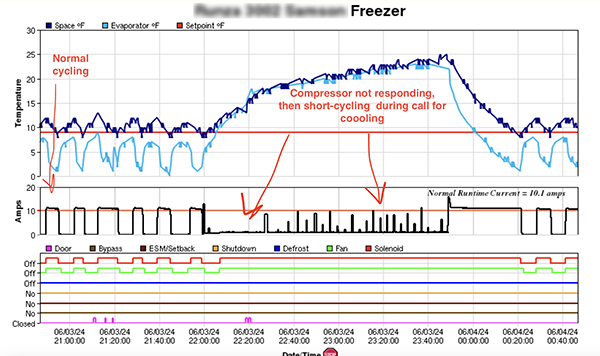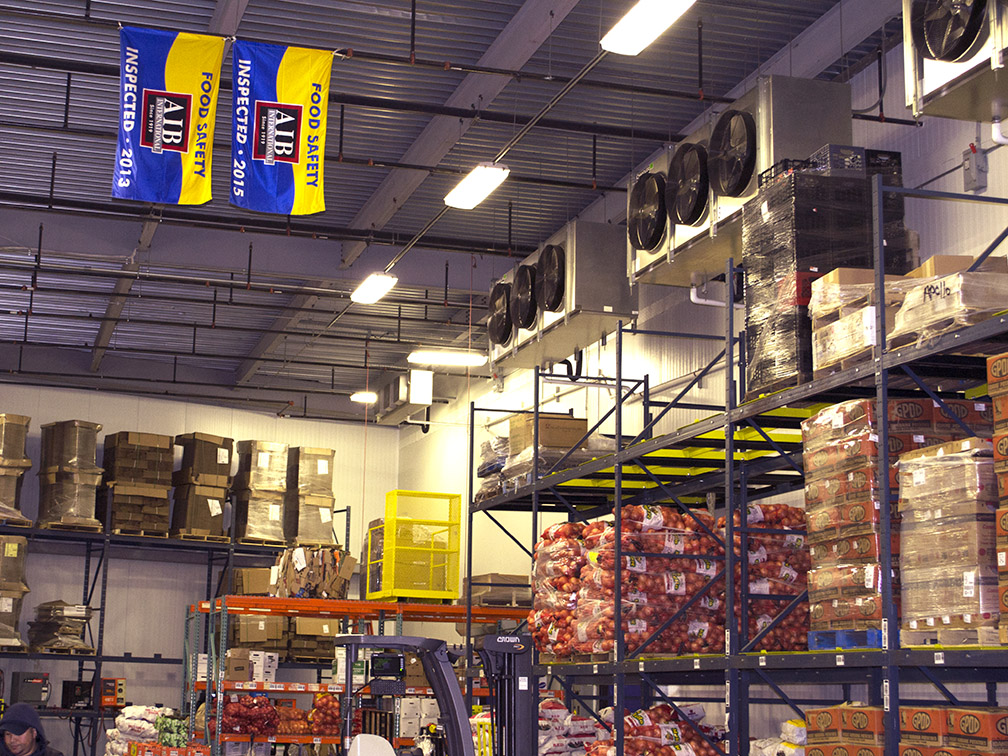In this new weekly blog series, NRM will highlight an issue a customer had and was able to resolve with our industry-leading control and monitoring solutions. Some of the most serious refrigeration problems can go undetected and result in equipment failures and/or product loss.
Problem of the Week: Why do Issues Wait Until the Weekend?
As is often the case with large, complex systems that we don’t personally have the appropriate knowledge or training for, owners/operators, mangers, and regular staff usually regard their business’ commercial or industrial refrigeration equipment with an “out of sight, out of mind” mentality. Without the necessary technical expertise to professionally diagnose a problem, they either pay the system little to no attention, or interact with it and don’t consider the consequences (because they’re not aware any exist). This can often lead to many, expensive service calls or, worse, an issue that can not only degrade the equipment but ruin it.
This new blog series, NRM’s Refrigeration Problem of the Week, will take a look at real-world situations where unique control and monitoring tools averted disaster for a business.
Today’s post will take a look at three different situations that presented the same conundrum, as well as the scariest scenario for any business owner or facilities manager: equipment issues arising during the weekend, when no one’s there to troubleshoot right away.
There are multiple reasons why anyone with large coolers and freezers would find this kind of scenario stressful and terrifying.
For starters, the continuous operation of a system experiencing malfunctions can waste a lot of energy and money in a 3-day period. For example, coils icing up and not having a defrost initiated can prevent a harmonious cooling process, preventing the normal flow of refrigerant into the system. The system won’t be able to satisfy temperature requirements, and the system will continue to call for cooling unsuccessfully.
That type of issue (a seemingly minor problem left unattended) also leads into the second reason why issues arising during the weekend are nightmare scenarios: operating with undetected mechanical problems can quickly lead to expensive, catastrophic system failure. Affording repairs and emergency maintenance calls are one thing, replacing compressors and entire refrigeration systems are another.
And the third, main reason weekend issues strike panic into the hearts of owners and operators (and the main thing our clients want to avoid when they seek our solutions): the potential loss of product. All of our clients store essential-to-their-business products (or specimens, in the cases of our healthcare and laboratory clients) in refrigerated spaces, and all of them have temperatures that need met at all times. A blood bank, for example, has strict government-regulated temperature requirements. A produce distributor has specific temperature ranges for ripening and storage. And if refrigeration systems in either of those scenarios fail, they’re each losing thousands to millions of dollars in crucial product. Often, this type of situation is a figurative nail in the coffin for businesses that don’t have corporate budgets or redundancies built into their facilities.
Here are three examples of different businesses that all faced this heart-wrenching scenario, and how they were able to avoid massive losses.
Example 1
One of our customers, a golf resort in California, has around 30 walk-in coolers and freezers at their location, managed by a small, dedicated team of technicians. On a Friday, the team had to perform repairs on a walk-in freezer and when they turned the system back on after having finished, the evaporator fans did not run. Thinking it was a potential issue with our smart controls, the technician reverted the refrigeration system back to its original setup (our controls have a bypass feature that allows them to be “invisible” when diagnosing and troubleshooting the equipment). This did turn the fans back on, and they went back to running at 100% capacity and ran for a handful of hours without issue.
However, as a result of still having the monitoring software (it works independently of the controller), the technician was alerted to the system short-cycling excessively in the early hours of Saturday morning. This informed the technician that there wasn’t a problem with NRM’s controls, but that a problem still existed within the components of the equipment itself (the reason the fans did not immediately come back on following the initial repair was because NRM’s smart controls adapt fan run times to space and coil temperatures — the coil temperatures, in this situation, did not require the fans to run when the system was turned back on).
The technician diagnosed the system again, and found that a small pilot relay had failed in the evaporator fans. The short cycling was caused by the system being low on refrigeration and the pressure switch kept turning off/pumping down when there wasn’t enough gas to pump.
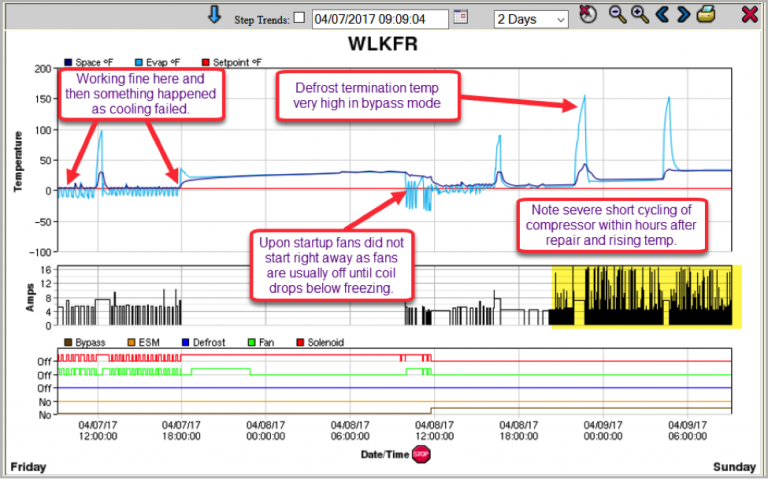
Example 2
On the same Friday night, another of our clients, a floral grower also on the west coast, experienced an off-hours issue with their solenoid valve. They received an alert that both space and coil temperatures were rapidly falling out of range. Looking at the performance trend in the online dashboard, it could be easily seen that there was a severe problem, because despite the temperatures getting colder, the system kept cooling the space. With no one at the facility to turn off the system, it was only because of the mobile access to NRM’s controls that the system could be shut down. This prevented catastrophic damage to the equipment as well as full inventory loss.
A technician went to the facility Monday morning and found the stuck solenoid valve that caused the refrigeration system to continuously pump cooling into the space despite the thermostat not calling for it. It turned out that a previous compressor had failed, and the technician at that time had not replaced the solenoid valve when they replaced the compressor. The new technician was able to remedy the mistake of his predecessor, and was able to save a second compressor the client.
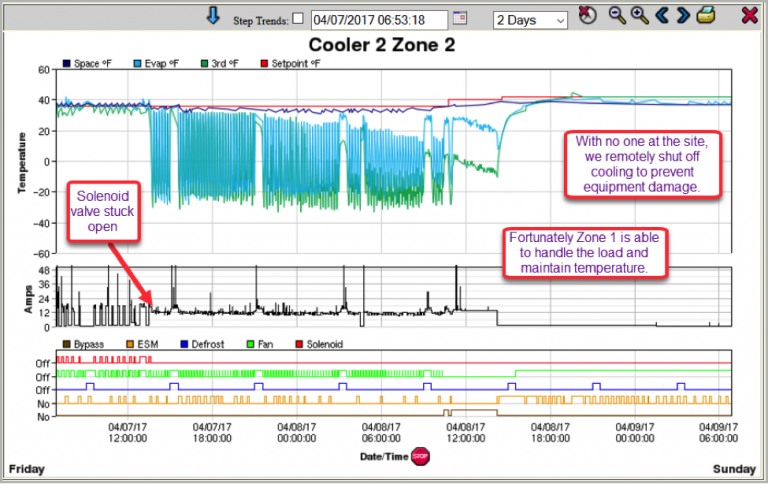
Example 3
A university client of ours, who has their entire campus of dining services coolers and freezers running on NRM’s controls platform, received a “Compressor at Risk” notification early one morning. Fortunately, the monitoring software was able to show their facilities manager in exactly which the cooler the compressor was malfunctioning, and when.
The performance trend provided in the online dashboard showed a very odd occurrence: space temperatures getting very high, while the coil temperature simultaneously got very low, and without a pattern. This malfunction appeared to happen randomly. Normally, when the space temperatures and the coil temperatures got like this in a cooler or freezer, it was due to the evaporator fans failing completely or someone manually turning off the fans in the space.
Being alerted to this abnormality, the technician was able to diagnose and trouble-shoot the compressor in this particular cooler. It was determined that the evaporator fan contactor had failed. Due to the smaller size of this particular cooler, without air movement from the fans running the space temperature sensor constantly saw dangerously high temperatures. And because the fans were off due to the faulty contactor, the coil temperature dropped too low. The technician replaced the contactor first thing Monday morning, and the system was running optimally again in no time.
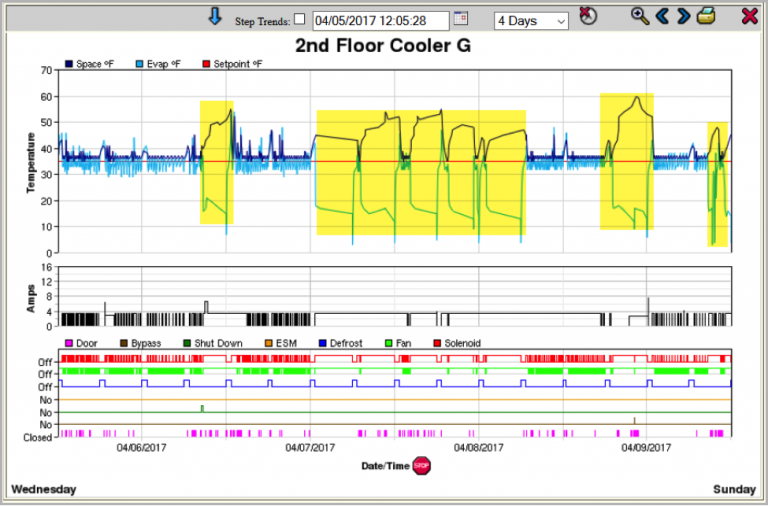
Follow-Up
These events bring up good questions about individual components in the system.
Like, how long do contactors last? And should they be replaced after a certain amount of time/use?
Contactors can be a low cost item but can cause costly failures to the more expensive components. Some of our contractor friends suggest developing a component replacement program where some contactors are replaced every 7-10 years. Doing so might result in fewer emergency calls as well as better protecting other system components. Perhaps you could wrap a component replacement program into your routine maintenance program.
We would like to hear your comments and suggestions as it relates to preventive maintenance.

